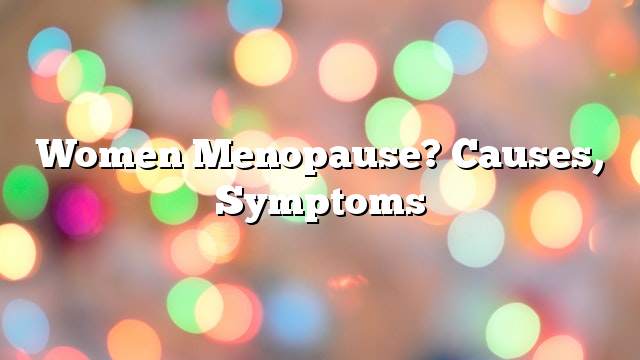The age of menopause is defined as the age at which the menstrual cycle stops automatically for more than 6 months. The average age is 51 years. With the increase in the average age of human life in general and women in particular, women may spend about 1/3 years of menopause and hence the interest in this period of women’s lives.
Physiological changes in menopause
• A significant reduction in the level of estrogen, most of which is the ineffective type called estrone.
• Progesterone, the hormone that causes ovulation, decreases. As the ovulation stops, the hormone stops the monthly increase in ovulation.
• A decrease in the level of the male hormone (Testosterone), and this decrease is much lower than the decline of estrogen, there is an increase in the ratio of hormone testosterone to estrogen, and this relative increase is responsible for the increase of male hair and thickness in women after menopause.
• An increase in the hormones of Gonadotropin (Gonadotropines), especially the hormone F. S. H, the hormone is measured to the nearest occurrence or incidence of menopause.
Clinical changes in menopause:
• Changes in the menstrual cycle, most women suffer from a gradual decrease in the amount and duration of the menstrual cycle before it is completely interrupted at the end of the period. Some women may experience a menstrual disorder with intense blood loss, and a sudden cessation of the cycle is rare.
• Sudden warming and night sweats occur in 85% of women and may range from 1 to 5 years.
• Changes in the vagina and bladder, changes in the lining of the vagina so that it becomes dry and thin, which makes women susceptible to inflammation, and pain during intercourse, and the same changes to bladder lining, women suffer from burning of urine and urinary frequency without the presence of infections.
• Changes in mood, memory and sleep, women suffer in this period of mood disorder, nervousness and tendency to depression and memory impairment and insomnia.
• Osteoporosis, after 35 years of age, women experience an accelerated lack of bone density. One out of every three women after 65 years of age suffers from spinal fracture, which makes women prone to fractures, especially in the vertebrae and in the bone of the wrist. And in the neck of the femur.
• Increased heart disease and blockage of the arteries.
Diagnosis of menopause:
Diagnosis is done through the pathology and symptoms of the patient, or through laboratory tests, which include examination of the hormone F. S. H and osteoporosis examination.
the cure:
Treatment for symptoms, such as hormone replacement therapy, is given to a patient with severe symptoms of estrogen deficiency, a patient with osteoporosis, and a patient with early menopause (before the age of 35).
Studies have shown that the minimum duration for which the patient benefits from prosthetic hormones is 7 years.
But this treatment has caveats, including:
1. The absolute caveats are that it is not permissible to use prosthetic hormones if they exist and include:
• uterine bleeding.
• Liver diseases.
• Heart attacks.
• Blood clots.
• Cancer of the uterus or breast.
2. The relative caveats in which prosthetic hormones can be taken according to the situation, including:
• Migraine headaches.
• Inflammation of the veins.
• Biliary gallbladder diseases
• Elevation of liver enzymes.
• Hypertension.
• Migratory endometriosis.
Risks of estrogen:
• Cancer of the uterus: the use of estrogen alone increases the risk of developing uterine cancer by 2-4 times. Therefore, progesterone is used periodically with it to counteract the lining of the uterus.
Breast cancer: The use of progesterone alone for more than 10 years increases the risk of breast cancer.
Biliary gallbladder diseases.
Treatment of compensatory hormones is by:
• the mouth.
• Skin patches.
• Topical vaginal treatment.
Supporting treatments:
• Herbs Belladona alkaloids
• Vitamin IU / 800 – 400 E 4 times daily.
